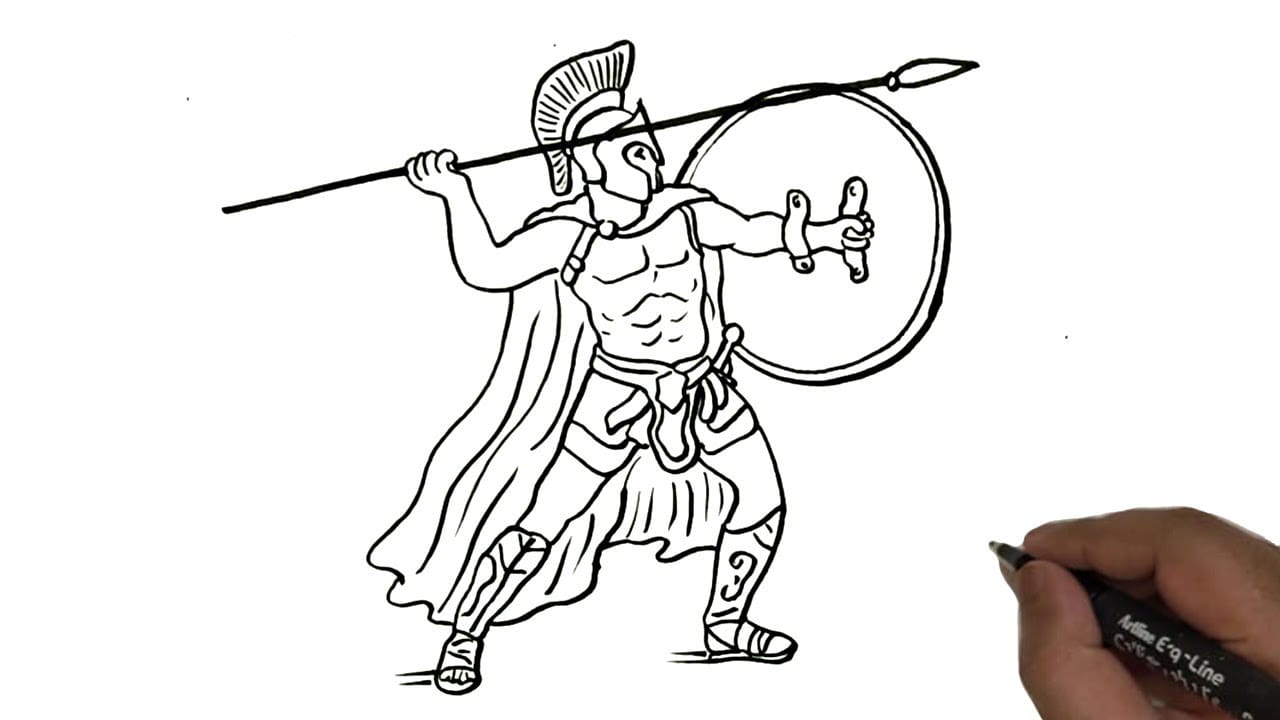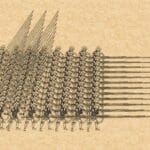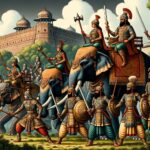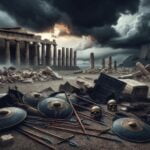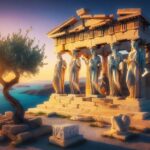Unmasking Spartan Military Secrets Through Art
We’ve all heard tales of the Spartans, the legendary warriors from ancient Greece. But beyond brute force, these strategic masterminds relied on innovative military formations, documented in ancient drawings and artwork. This guide dives deep into these formations, deciphering the secrets that made the Spartan army an unstoppable force.
Ancient Art Meets Military Tactics
Spartans were surprisingly artistic, using their talents to record their military prowess for posterity. With no cameras in ancient Greece, these drawings offer a fascinating glimpse into their strategies and battlefield organization.
1. Lakonian Black-Figure Pottery: Art You Can Drink From
Imagine sipping wine from a clay cup adorned with battle scenes! This was everyday life for the Spartans. They favored Lakonian black-figure pottery, popular during the 7th and 6th centuries BC, which often depicted hoplites, their elite infantry soldiers, arranged in various formations. These images weren’t merely decorative; they likely served as visual aids for understanding and perhaps even planning military maneuvers.
2. Bronzework: Small Sculptures, Big Impact
The Spartans didn’t limit their use of bronze to weapons and shields. They were masters of crafting small bronze statues, many showcasing warriors in formation. These sculptures provide a detailed look at the Spartan army’s gear and tactics, acting as miniature three-dimensional models of their military might.
Decoding the Drawings: Becoming a Spartan Formation Detective
These drawings are like ancient battle plans, offering clues about the Spartans’ military dominance. Deciphering them is like piecing together a puzzle, but with the right approach, we can unlock their secrets.
1. Spot the Patterns: The Spartans loved a good, organized battle plan, and this is reflected in their formations. Look for repeating patterns, like the iconic phalanx formation, where hoplites formed a seemingly impenetrable wall of shields and spears.
2. Zoom in on the Details: Tiny details matter! The type of weapons, armor, and even the positioning of warriors can reveal their roles within the army. For instance, slight variations in helmet crests could denote different ranks or experience levels.
3. Hit the Books (or the Internet): Extensive research exists on Spartan warfare. By understanding their different formations, weaponry, and strategies, you’ll be better equipped to interpret the visual clues presented in the drawings.
The Mystery Continues…
We’re still learning from these ancient drawings today. Archaeologists and historians are constantly unearthing new clues and debating their interpretations. It’s an ongoing historical puzzle that continues to captivate and challenge our understanding of these ancient warriors.
Unleashing the Power of Spartan Symbolism
Beyond their impressive formations, Spartans employed powerful symbols that embodied their military might and societal values. Understanding these symbols is key to unlocking the deeper meaning behind their art and warfare.
The Lambda: More Than Just a Letter
The Lambda (Λ), a stylized “L,” was more than just a letter to the Spartans. It represented Lacedaemon, the region encompassing Sparta, and became synonymous with their military prowess. When enemies saw the Lambda on the battlefield, they knew they faced the legendary Spartan army, striking fear and representing an almost insurmountable challenge.
Shields of Unity: A Canvas for Individuality and Collective Strength
Spartan warriors were known for their uniformity, but their shields offered a glimpse into their individuality within the collective. While adorned with the iconic Lambda, warriors personalized their shields with symbols and designs, much like a warrior’s coat of arms.
- Mythological Motifs: Roosters, associated with Apollo, god of the sun, were common. Bulls, boars, centaurs, and snakes, representing strength and ferocity, were also popular choices.
- Potential Meanings: These symbols could represent personal beliefs, family lineage, or even distinguish specific military units within the Spartan ranks.
The Weight of Honor: The Spartan Shield’s Deeper Meaning
In Spartan society, a warrior’s shield held profound meaning beyond its practical use.
- Symbol of Honor: Returning home with your shield signified valor and loyalty to Sparta. To lose it in battle brought immense shame, marking the individual as a coward or deserter.
- Quote: “A Spartan’s shield [is] not just for his own protection, but for the whole line.” – King Demaratos (This quote emphasizes the collective responsibility embodied by the shield.)
- The Phalanx Formation: The shield’s importance is evident in their phalanx formation. Interlocking shields created a formidable wall, symbolizing unity, discipline, and shared responsibility – core Spartan values.
Beyond the Shield: The Spartan Helmet
Often overshadowed by the shield, the Spartan helmet played an equally important symbolic role.
- Horsehair Crest:
- The helmet’s tall crest made warriors appear more imposing on the battlefield.
- The crest’s design marked rank and experience, with variations indicating status and role within the Spartan military structure.
- Facial Protection:
- Bronze construction protected against blows, essential in close-quarters combat.
- Design variations could indicate status or role, further emphasizing the importance of visual cues in Spartan warfare.
Unveiling the Spartan Formation: The Phalanx
The Spartan phalanx, a rectangular formation of heavily armored hoplites, was a symbol of their military prowess. Imagine a wall of bronze shields, glinting in the sun, advancing with unwavering discipline—a terrifying sight for any enemy.
The Anatomy of a Formation
The phalanx’s effectiveness lay in its structure and the training of its soldiers.
- Hoplites: Each hoplite was equipped with a hoplon (shield), a dory (spear), and a xiphos (short sword).
- Structure: The phalanx was typically 8-12 ranks deep, with the most experienced soldiers at the front.
- Shields: Overlapping hoplons created a near-impenetrable shield wall. This formation protected each soldier and his comrade to the left, emphasizing collective defense.
- Spears: Protruding from behind the shield wall, the dory created a deadly obstacle for any enemy that dared to approach.
Tactical Advantages: Why the Phalanx Reigned Supreme
The Spartan phalanx, combined with their rigorous training, offered numerous tactical advantages:
- Cohesion and Discipline: Years of training instilled unwavering discipline. The phalanx moved as a single, coordinated unit, capable of complex maneuvers and swift adaptations to changing battlefield conditions.
- Psychological Warfare: The sight of an advancing Spartan phalanx, a wall of bronze and iron, was often enough to break enemy morale before the battle even began.
- Momentum: The combined weight and momentum of the formation, particularly on flat terrain, made frontal assaults devastatingly effective.
- Esprit de Corps: Fighting shoulder-to-shoulder fostered an unparalleled sense of camaraderie and brotherhood, motivating each soldier to fight fiercely for his comrades.
Beyond the Shield Wall: Weaknesses of the Phalanx
Despite its strengths, the phalanx had weaknesses that cunning enemies could exploit.
- Vulnerability to Flanks: The formation’s primary weakness was its vulnerability to attacks from the sides or rear, where the shield wall offered less protection.
- Terrain Dependence: Uneven terrain or obstacles could disrupt the phalanx’s cohesion, making it vulnerable to more agile opponents.
- Tactical Limitations: While excelling in direct confrontations, the phalanx was not designed for complex maneuvers or pursuing a fleeing enemy. It lacked flexibility in response to unconventional tactics.
The Battle of Leuctra (371 BC): A Turning Point
The Battle of Leuctra marked a turning point for the Spartan phalanx. Thebes, led by the brilliant strategist Epaminondas, devised a plan to counter Sparta’s military superiority.
- Theban Innovation: Epaminondas concentrated his forces on one flank, aiming to overpower the typically formidable Spartan right, where elite troops were stationed. This tactic, known as the oblique order, proved effective in exploiting the phalanx’s inherent weakness.
- The End of an Era: The Theban victory shattered the myth of Spartan invincibility and signaled the decline of the phalanx’s dominance in ancient warfare.
Decoding Spartan Art: Looking Beyond the Battlefield
While Spartan art might not be as famous as Athenian art, it offers a fascinating glimpse into their culture and values. From pottery to bronzework, Spartan art reflects their unique style and worldview.
Challenging the “Warrior-Only” Narrative
Spartans are often perceived as solely focused on warfare, neglecting their artistic expressions. However, archaeological evidence from the 7th and 6th centuries BC reveals a flourishing artistic culture in Sparta and the surrounding Lakonia region. Workshops specializing in pottery, metalwork, ivory and bone carving, and stone sculpture thrived during this period.
Lakonian Black-Figure Pottery: A Glimpse into Spartan Life
Lakonian black-figure pottery, flourishing in the 6th century BC, provides valuable insights into Spartan culture.
- Distinctive Style: While adopting the black-figure technique from Corinth, Lakonian pottery developed a unique style and iconography distinct from Athenian counterparts.
- Subject Matter: Beyond battle scenes, Lakonian pottery depicted mythology, scenes from daily life, and symbolic figures.
- Widely Traded: The discovery of Lakonian pottery in regions like the Greek East, North Africa, and Italy suggests a thriving trade network and Spartan influence on other artistic traditions.
Lakonian Bronzework: Masters of Metal
Spartan bronzework, particularly their small-scale sculptures, demonstrates their mastery of metal. These intricate pieces showcase their craftsmanship and attention to detail, offering a window into their artistic sensibilities.
Lost Masterpieces and Remaining Treasures
Unfortunately, many large-scale Spartan artworks, including sculptures and buildings, are lost to history due to the passage of time and the perishable nature of some materials. However, surviving pottery fragments, bronze artifacts, and ivory carvings provide valuable insights into Spartan artistic styles, themes, and techniques. These remaining treasures are crucial for reconstructing a more complete understanding of Spartan art beyond the battlefield.
The Spartan Shield Formation: A Deeper Dive
The Spartan shield formation, often referred to as the phalanx, was more than just a defensive tactic; it was a symbol of Spartan society, discipline, and military might.
Introduction: Setting the Stage
Imagine a battlefield in ancient Greece. The ground trembles as a wall of bronze advances, an unyielding force of nature. This was the Spartan phalanx in action, a formation that struck fear into the hearts of their enemies.
Anatomy of the Phalanx: The Shield Wall Dissected
The phalanx’s effectiveness lay in its simple yet deadly design:
- Hoplon (Shield): The hoplon was a large, round shield made of wood and covered in bronze. At approximately 3 feet in diameter and weighing around 30 pounds, it provided significant protection.
- Grip and Armband: The unique grip system, with a central grip and an armband, allowed Spartans to maneuver the shield offensively, using its weight to push and shove enemies off balance.
- Symbolism: The hoplon transcended its practical function to become a symbol of Spartan identity, representing their unwavering courage and commitment to their comrades.
- Spear (Dory): The dory, a 7-9 foot spear, was the phalanx’s primary offensive weapon. It was typically made of wood with an iron spearhead.
- Use in Formation: The first few ranks of the phalanx held their dories outstretched, creating a dense wall of spearpoints. This design maximized their reach and created a terrifying obstacle for approaching enemies.
- Formation:
- Structure: The phalanx was a line of hoplites, typically 8 ranks deep, standing shoulder-to-shoulder. Each soldier’s shield overlapped with the man to his right, creating a continuous ‘wall’ of bronze.
- Maneuvering: Rigorous training allowed the phalanx to move as a single unit. They could pivot, advance, and maintain cohesion even in chaotic battles.
The Spartan Advantage: Strengths of the Phalanx
Why was the Spartan phalanx so effective?
- Psychological Warfare: The sight of the advancing phalanx, an unyielding force of bronze and muscle, was often enough to break enemy morale.
- Discipline and Training: The Spartan agoge, their brutal training regimen from childhood, instilled unwavering discipline, obedience, and teamwork—essential for the phalanx’s success.
- Synergy of Offense and Defense: The phalanx seamlessly integrated offense and defense, using the shields for both protection and to create openings for spear thrusts.
- Historical Examples: The phalanx’s effectiveness is evident in battles like Thermopylae and Plataea, where the Spartans held off vastly superior forces.
Cracks in the Wall: Weaknesses of the Phalanx
Despite its fearsome reputation, the phalanx was not invincible.
- Vulnerability to Flanking: If an enemy force could break through or outmaneuver the Spartan flanks, the phalanx’s strength became its weakness.
- Terrain Dependence: The phalanx performed best on flat, open terrain. Uneven ground or confined spaces could disrupt the formation, hindering its effectiveness.
- New Tactics: As military thinking evolved, new tactics emerged to counter the phalanx. For instance, the Theban oblique formation, a diagonal attack strategy, proved effective in exploiting the phalanx’s linear structure.
- Decline of Spartan Society: As Sparta’s societal discipline waned, so did the effectiveness of their army. The phalanx relied on unwavering obedience and training, and as Spartan society changed, their military prowess declined along with it.
The Legacy of the Spartan Shield Wall
The Spartan phalanx, though eventually superseded by new tactics and technologies, left an indelible mark on military history.
- Military Influence: The phalanx’s influence can be seen in the formations of other ancient armies, including the Romans and Macedonians, who adapted and refined the concept.
- Cultural Icon: The image of the Spartan phalanx, a symbol of courage, discipline, and sacrifice, continues to captivate and inspire today. It has been featured in literature, film, and even video games, cementing its place in popular culture.
By understanding the intricacies of Spartan art, symbolism, and formations, we gain a deeper appreciation for their military achievements and cultural legacy. The Spartans, though long gone, continue to fascinate and inspire us with their unwavering dedication, discipline, and the enduring power of their iconic shield wall.
- Crypto Quotes’ Red Flags: Avoid Costly Mistakes - June 30, 2025
- Unlock Inspirational Crypto Quotes: Future Predictions - June 30, 2025
- Famous Bitcoin Quotes: A Deep Dive into Crypto’s History - June 30, 2025
